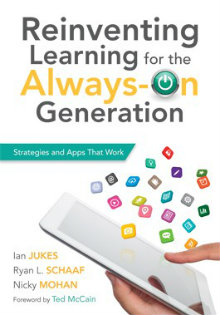Learning to Teach the Always-On Generation
Reinventing Learning for the Always-On Generation: Strategies and Apps That Work
By Ian Jukes, Ryan L. Schaaf, and Nicky Mohan
(Solution Tree Press, 2015 – Learn more)

Finishing the book Reinventing Learning for the Always-On Generation: Strategies and Apps That Work by Jukes, Schaaf and Mohan left me with some mixed emotions.
I felt inspired to try harder, overwhelmed by the rapid pace technology is changing, frustrated with the progress education is making to meet the needs of 21st century learners, relieved it was summer when I read this book and I had time to process its contents, and feeling every year of my age.

I am a work in progress on the use of technology. It can be a steep learning curve at times, so I was glad to read details of ways to teach more effectively and with additional relevance. At the pace the book mentions that technology is developing, it will be a challenge for any teacher to keep up.
Acknowledging how kids learn today
Balance is what the authors suggest we find between the more traditional methods of teaching and the techniques that digital learners find more engaging. If teachers keep an open mind with a willingness to change some methods, progress can be made.
The authors are not suggesting we “throw the baby out with the bathwater” by redesigning all aspects of teaching, but they make a strong case for giving students options for how they approach the things we want them to learn. Teachers facilitate the learning and place more ownership on students. Teachers still are in charge of what is learned, just not always how it is learned.
An excellent book study choice
The book format lends itself to a book study. Each chapter is summarized with the main points and some thought provoking questions. The authors give tips on how to read the book in the Introduction so that you address the chapters most relevant to you. Suggestions for future reading are also included.
Many teachers may need to be informed or reminded about several ideas that the authors share. Our ability to adapt is not a function of our age so much as our ability to try new ideas while still maintaining the curriculum content we know is important.
Administrators need to share this gem of a book with their staff since the majority of teachers were not trained with these methods in mind. Professional development should include sections of the text such as Chapter 3: Kids Are Different – so we better understand the true impact of digital bombardment and how it affects the way children learn today.
The way we grew up is not how these children are growing up, and the difference gap is widening as the years pass. Chapter 4: A Need for Speed focuses on students processing information at “twitch speed,” and the fear that they are missing out leaves them with some anxiety as they rush to keep up.
I was glad to see the descriptions of many sites and apps that I use with students throughout the book and to gain more information on strategies I have not yet tried. Teachers need time to gain confidence in using these tools whereas students tend to dive in and gain proficiency as they go.
Content highlights
Every chapter has important information to share with the reader, but for those who are creating documents of any type to be used by digital age learners, be sure to read Chapter 8: Fast Pattern Reading. Seeing the differences in reading styles from a (old time) Z to a (current) F pattern will help us create more readable pages. Thermographic heat scans are shared to show how the average digital reader looks at a page. Color photos of these scans would have added to this content, but the authors do provide references so they can be looked up online.
Just-in-case vs. just-in-time learning is debated in Chapter 9, and is one of many eye-openers in the book. To prepare students for jobs that do not yet exist and for their predicted rapid change in careers is no small undertaking. However, the authors provide more strategies and tools so that educators can attempt to meet this challenge.
There are many nuggets to be gleaned from this book. Some of the ideas worth further investigation are:
- “Gamers spend 80 percent of their time failing, yet still have a positive experience and retain positive emotions.”
- “There’s nothing worse than getting caught with your paradigm down.”
- “… gone from being teenagers to screenagers.”
- “death of patience.”
- “death of distance.”
- “butterfly brain effect” (skim and skip approach), and
- “Technology is not new if you were born to it.”
I would add MiddleWeb to the list of professional education blogs found on page 81, but the authors do list several others that are worth following. To continue to meet the needs of digital learners, this book would need to be updated or available as an e-book with ongoing revisions.
A guide to getting on board today’s tech
We will never go back to the way I taught my first year (1978-79), and we shouldn’t – not with the changes we have experienced since then. It is past time for all educators to get on board with some new and better ways to teach today’s learners.
I look forward to implementing many of these ideas and commend the authors who collaborated across several continents to produce a very useful resource for all who work with digital learners. One question they ask all teachers to ponder is this:
“Would students choose to be in your classroom if they didn’t have to be there?”
I hope to be able to ask that question of my students with a higher rate of approval after using this book!
Joyce Depenbusch is a middle and high school science teacher in rural south central Kansas. She has also taught math, history and literature during her career. Before this, she was the wildlife education coordinator for the State of Kansas. She has degrees in wildlife biology, education and English as a Second Language. Joyce enjoys presenting at workshops about ways to implement the NGSS.




























